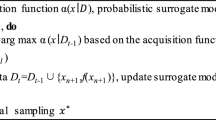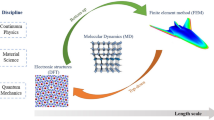Abstract
Accuracy of numerical models based in finite elements (FE), extensively used for simulation of cutting processes, depends strongly on the identification of proper material parameters. Experimental identification of the constitutive law parameters for simulation of cutting processes involves unsolved problems such as the complex testing techniques or the difficulty to reproduce the stress triaxiality state during cutting. This work proposes a methodology for the inverse identification of the material parameters from cutting test. Two hybrid approaches are compared. One of them based on FE and artificial neural networks (ANN). The other one based on FE and local polynomial regression (LPR). Firstly, a FE model is validated with experimental data. Then, ANN and LPR are trained with FE simulations. Finally, the estimated ANN and LPR models are used for the inverse identification of material parameters. This identification is solved as an optimization problem. The FE/LPR approach shows good performance, outperforming the FE/ANN approach.
Similar content being viewed by others
References
Gonzalo O, Jauregi H, Uriarte L, López de Lacalle L (2009) Prediction of specific force coefficients from a FEM cutting model. Int J Adv Manuf Technol 43:348–356
Davim J, Maranhão C, Jackson M, Cabral G, Grácio J (2009) FEM analysis in high speed machining of aluminium alloy (Al7075-0) using polycrystalline diamond (PCD) and cemented carbide (K10) cutting tools. Int J Adv Manuf Technol 39:1093–1100
Tounsi N, Vincenti J, Otho A, Elbestawi MA (2002) From the basics of orthogonal metal cutting toward the identification of the constitutive equation. Int J Mach Tools Manuf 42/2:1373–1383
Kuo C-FJ, Wu Y-S (2005) Application of a Taguchi-based neural network prediction design of the film coating process for polymer blends. Int J Adv Manuf Technol 27:455–461. doi:10.1007/s00170-004-2215-3
Kohli A, Dixit US (2005) A neural-network-based methodology for the prediction of surface roughness in a turning process. Int J Adv Manuf Technol 25(1/2):118–129
Sanjay C, Jyothi C (2006) A study of surface roughness in drilling using mathematical analysis and neural networks. Int J Adv Manuf Technol 29:846–852
Härdle W (1990) Applied nonparametric regression. Cambridge University Press, Cambridge, UK
Umbrello D, Ambrogio G, Filice L, Shivpuri R (2008) A hybrid finite element method–artificial neural network approach for predicting residual stresses and the optimal cutting conditions during hard turning of AISI 52100 bearing steel. Mater Design 29:873–883
Chamekh A, Bel Hadj Salah H, Hambli R (2009) Inverse technique identification of material parameters using finite element and neural network computation. Int J Adv Manuf Technol 44:173–179. doi:10.1007/s00170-008-1809-6
Fernández-Fdz D, Zaera R (2008) A new tool based on artificial neural networks for the design of lightweight ceramic–metal armour against high-velocity impact of solids. Int J Solid Struct 45:6369–6383
Miguélez MH, Zaera R, Molinari A, Cheriguene R, Rusinek A (2009) Residual stresses in orthogonal cutting of metals: the effect of thermomechanical coupling parameters and of friction. J Therm Stresses 32(3):269–289
Johnson GR, Cook WH (1983) A constitutive model and data for metals subjected to large strains, high strain rate and temperature. In: Proc 7th Int Symp on Ballistics. pp. 541–547.
Muñoz-Sánchez A, Miguélez H, Canteli JA, Cantero JL (2009) The influence of tool wear in surface integrity when machining austenitic stainless steel. In: 9th International Conference on the Mechanical and Physical Behaviour of Materials under Dynamic Loading (DYMAT 2009), Brussels, Belgium
Umbrello D, M’Saoubi R, Outeiro JC (2007) The influence of Johnson–Cook material constants on finite element simulation of machining of AISI 316L steel. Int J Mach Tools Manuf 47:462–470
Hibbit Karlson and Sorensen Inc (2003) ABAQUS User’s Manual 6.4–1
Adetoro OB, Wen PH (2010) Prediction of mechanistic cutting force coefficients using ALE formulation. Int J Adv Manuf Technol 46(1/4):79–90
Miguélez H, Muñoz-Sánchez A, Cantero JL, Loya JA (2009) An efficient implementation of boundary conditions in an ALE model for orthogonal cutting. J Theor Appl Mech 47(3):1–20
Miguélez MH, Zaera R, Molinari A, Muñoz-Sánchez A (2009) The influence of cutting speed in the residual stresses induced by HSM in AISI 316L steel, 12th CIRP Conference on Modelling of Machining Operations. San Sebastián, Spain.
Moufki A, Molinari A, Dudzinski D (1998) Modelling of orthogonal cutting with a temperature dependent friction law. J Mech Phys Solids 46/10:2103–38
Nasr MNA, Ng EG, Elbestawi MA (2008) A modified time-efficient FE approach for predicting machining-induced residual stresses. Finite Elem Anal Des 44:149–161
Jang DY, Watkins TR, Kozaczek KJ, Hubbard CR, Cavin OB (1996) Surface residual stresses in machined austenitic stainless steel. Wear 194:168–173
Korkut I, Kasap M, Ciftci I, Seke U (2004) Determination of optimum cutting parameters during machining of AISI 304 austenitic stainless steel. Mater Design 25:303–305
Haykin S (2007) Neural networks: a comprehensive foundation. Prentice Hall, Englewood Cliffs, NJ
Shao J (2003) Linear Model Selection by Cross-Validation. J Amer Stat Assoc 88:486–494
Chen S, Cowan CFN, Grant PM (1991) Orthogonal least squares learning algorithm for radial basis function networks. IIEE Trans Neur Netw 2:302–309
Goldberg DE (1989) Genetic Algorithms in Search, Optimization and Machine Learning. Kluwer Academic Publishers, Boston, MA
Zouhar J, Piska M (2008) Modelling the orthogonal machining process using cutting tools with different geometry. MM Sci J 48–51
Borkovec J, Petruska J (2007) Computer simulation of material separation process. In: Proc. Engineering Mechanics, Svratka, Czech Republic. p. 14.
Forejt M (2004) The mechanical properties of selected types of steel in the condition of higher speed deformation. Report of Research plan MSM 262100003, Brno University of Technology, Institute of Manufacturing Technology, Czech Republic
Jaspers SPFC, Dautzenberg JH (2002) Material behaviour in conditions similar to metal cutting: flow stress in the primary shear zone. J Mater Process Technol 122:322–330
Özel T, Zeren E (2005) Finite element modeling of stresses induced by high speed machining with round edge cutting tools. ASME International Mechanical Engineering Congress & Exposition, Orlando
Outeiro JC, Umbrello D, M’Saoubi R (2006) Experimental and numerical modelling of the residual stresses induced in orthogonal cutting of AISI 316L steel. Int J Mach Tool Manufact 46(14):1786–1794
Chandrasekaran H, M’Saoubi R, Chazal H (2005) Modelling of material flow stress in chip formation process from orthogonal milling and split Hopkinson bar tests. Mach Sci Technol 9:131–145
M’Saoubi R (1998) Aspects Thermiques et Microstructuraux de la coupe. Application a la coupe orthogonale des aciers austenitiques. Ph.D. Thesis, ENSAM-Paris
Changeux B, Touratier M, Lebrun JL, Thomas T, Clisson J (2001) High-speed shear tests for the identification of the Johnson–Cook law. Fourth International ESAFORM Conference. pp. 603–606
Author information
Authors and Affiliations
Corresponding author
Rights and permissions
About this article
Cite this article
Muñoz-Sánchez, A., González-Farias, I.M., Soldani, X. et al. Hybrid FE/ANN and LPR approach for the inverse identification of material parameters from cutting tests. Int J Adv Manuf Technol 54, 21–33 (2011). https://doi.org/10.1007/s00170-010-2922-x
Received:
Accepted:
Published:
Issue Date:
DOI: https://doi.org/10.1007/s00170-010-2922-x




